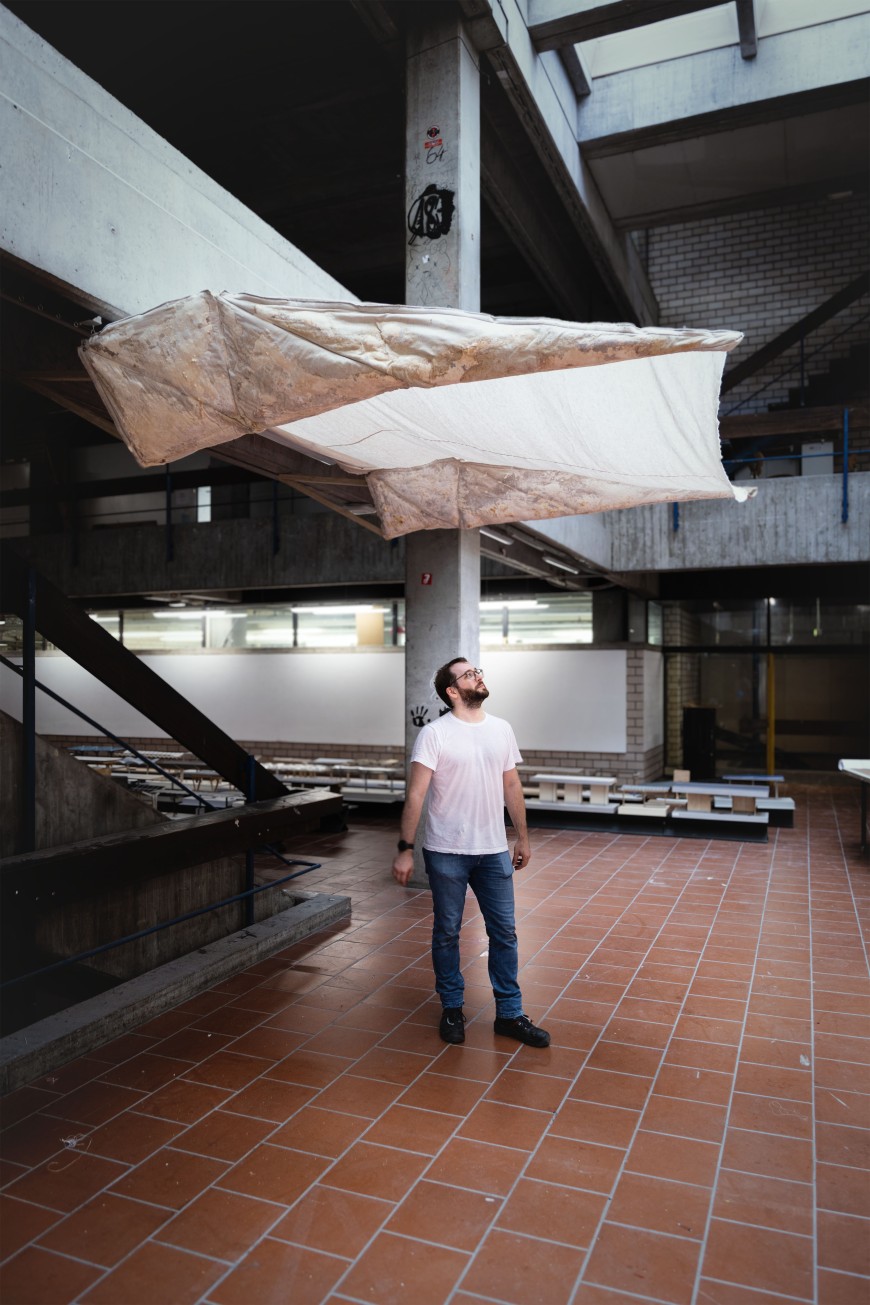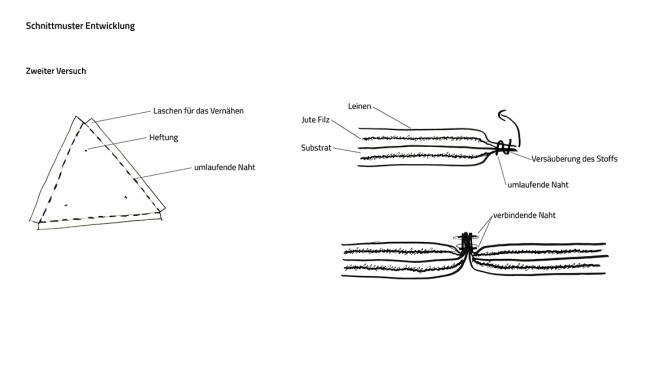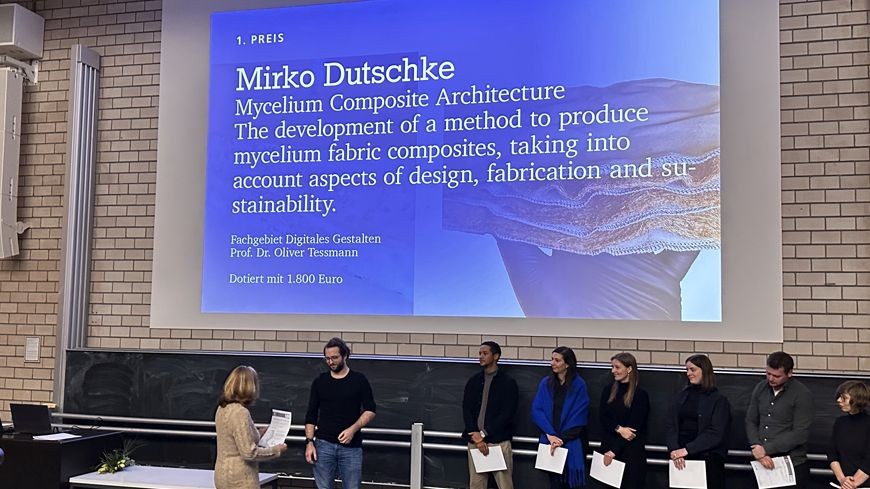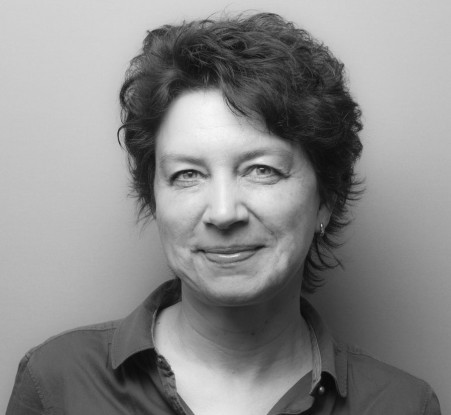Mycelium, the root-like structure of fungi, is explored in architectural research and first practical projects. The state of the art is mostly either the use as a compression-active block material, (Heisel et al., 2017) or as non-structural cladding, interior outfit material (Vandelook et al., 2023). First demonstrators of mycelium composites are shown by research institutes like the Royal Danish Academy of Fine Arts (Rigobello et al., 2022) and the Kassel University/KIT/ KU Leuven (Özdemir et al., 2022). In his thesis Mirko Dutschke aims at surpassing compression-only mycelium structures by developing multi-layered mycelium-textile composite elements that are able to take tension loads.
Background
Mycelium, as a building material, is a living and growing organism. This makes working with it fundamentally different than for example working with wood. Mycelium growth needs controlled environmental and nutritional conditions. Mirko uses a wood-decomposing fungus named Ganoderma lucidum. It grows best on wood-based materials. This makes beechwood an ideal substrate.
The wood is moisturized and sterilized using an autoclave or oven before adding the mycelium spawn. This mixture is left to colonized and grow in the incubator, creating a dense network of fibrous roots through the substrate. This step is important to reduce the growing period of the next step.
After about a week in the incubator the substrate gets broken down into smaller pieces and filled into the mold and put back into the incubator for eight to ten days. This step shapes the mycelium and creates the final component.
After removing the piece from its mold, it is dried, killing the mycelium.
Material Research
To reach the goal of a mycelium material that can withstand tensile forces it has to be combined with textile reinforcement. Mirko tested multiple textile/mycelium layering combinations. The most successful version is a stack of linen, mycelium, jute felt and mycelium. The felt layer is needed to regulate humidity and oxygen flow through the piece. It is called a “breather layer”.
The second goal is the removal of the need for plastic molds commonly used in mycelium cultivation. This is achieved by mounting the filled textile stack in a wooden frame tensioned by a twine. Using this method Mirko created two composite prototypes capable of taking considerable bending and tension forces, compared to the non-reinforced mycelium elements.
Environmental Factors
Mirko’s experiments have shown the importance of environmental factors when it comes to growing mycelium components. Avoiding the use of plastic molds makes it even more important to create the controlled growth conditions. Low humidity and temperature hampers growth and dries the substrate. Low humidity and perfect temperature cause the mycelium to start growing the fruiting body, recognizable by the darker spots appearing on the surface.
Ideal growing conditions produce a white camembert-like surface.
Design
The gallery space on the first floor of the architecture department offers various interaction possibilities of the mycelium elements with the existing structure. The open space provides views from multiple perspectives, as well as from above.
To arrange the object in the space, a 3D scan based on photogrammetry data was created. This makes it possible to check the spatial effect at any point in the design process and ensure that the design integrates well with its proportions into the existing space.
The existing structure has been incorporated into the design. The demonstrator is exposed by being attached to a beam, which places the focus on the supporting structure, highlighting the material properties. The ability to transfer compressive and tensile forces is a unique feature of the Mycelium Textile Composite.
Between the two cantilevering mycelium composite beams a linen canopy is spanned. The mycelium textile components are attached to wooden consoles that align the elements and interface them to the mounting rails on the underside of the concrete beams. Additionally, growth-related differences in the shape of the beams needed to be compensated.
To complete the design process, the shape of the beam was verified in Rhino using a Kangaroo physics simulation of pre-tensioned membranes.
Mycelium Textile Workflow
Using textile reinforcements alters the conventional mycelium workflow of pouring mycelium/substrate mix into a mold. It has to be adapted to work with the large multi-part textile elements. Instead, the substrate together with distilled water is crushed into a paste with a mixer. It is important to ensure that the temperature in the mixer does not exceed 26°C. The paste is then filled poured between the textile layers.
The mycelium grows through the layers and connects them. This results in a stable part that combines the properties of the mycelium with those of the fabric.
Cutting Pattern Development
Based on the design the linen and jute felt layers have to be tailored and cut. This requires a cutting pattern, based on the designs dimension. It is achieved by unfolding the object and adding tabs and sowing paths to the separate pieces parametrically.
First experiments have shown that sewing the pieces together is the most time-consuming step. Stitching the pieces together with a sewing machine before sterilizing them cuts down the required time by about 75%.
The production of the demonstrator starts with the setup of the incubator. For this Mirko separated a corner of a garage with plastic sheets to create a buffer room. In this room he placed an incubator for the substrate bags, as well as the frame into which the filled textile sheets are clamped.
Recommended external content
We have selected external content from YouTube for you and would like to show it to you right here. To do this, you must reveal it with one click. You can hide the external content at any time with another click.
I agree to external content from YouTube being shown to me. This may result in personal data being transmitted to third-party platforms. You can find more information in our Privacy Policy.
The frame is made of aluminium profiles, which allow for precise alignment. Additionally, a stable material is needed to support the textile elements in their wet, heavy state.
It also forces the object into its intended shape during drying, keeping the dimensions accurate where precision is needed.
Installation
The demonstrator was set up on the first floor of the architecture department at TU Darmstadt. A series of eyelets attached to the underside of a beam was used for mounting. Hooks were screwed into the wooden frames of the beams, onto which the elements were hung in the eyelets.
The fabric is provisionally fastened to the two beams and then tensioned from the tip to the base. It was important to start with the weaker beam to avoid overloading the material. The second beam was sturdy and could handle the tensile forces without any issues.
To be able to reuse the fabric between the beams in the future, Mirko refrained from cutting it and instead tucked the protruding sides inside the beams before fastening them.
The entire assembly could be carried out by one person.
Recommended external content
We have selected external content from YouTube for you and would like to show it to you right here. To do this, you must reveal it with one click. You can hide the external content at any time with another click.
I agree to external content from YouTube being shown to me. This may result in personal data being transmitted to third-party platforms. You can find more information in our Privacy Policy.
Outlook
Interior building components are subject to constant change and refurbishment. The speed of this change is dependent on their use. Considering a building according to the principle of “Shearing Layers” by Fran Duffy and Steward Brand (Stewart, 2007).), a building is divided into six layers: the site, the structure, the skin, the services, the space plan, and the stuff.
Comparing the material requirements for each layer with the properties of mycelium textile composites, the space plan and the stuff layer are suitable to be made from mycelium textile composites. The faster refurbishment cycle is suitable for a material that can be repeatedly used in a circular process.
Gypsum, as a critical material in indoor building construction, is facing potential scarcity due to a combination of environmental, economic, and geopolitical factors. Natural gypsum reserves are being depleted. Therefore 55% of the annual gypsum demand in Germany is covered by so-called FGD gypsum. FGD stands for flue-gas desulfurization systems. In the cleaning of exhaust gases, for example from lignite power plants, calcium compounds react with the sulphur dioxide contained in the exhaust gas to form gypsum. However this synthetic gypsum production is declining as many countries transition to renewable energy. Additionally, gypsum recycling remains limited due to logistical challenges and contamination issues. Environmental concerns, such as habitat destruction, water pollution, and carbon emissions from gypsum mining and processing, have led to stricter regulations, which may further reduce supply. Therefore, it is a good time to seek for alternative material systems.
References
Heisel F., Schlesier K., Lee J., Rippmann M., Saeidi N., Javadian A., Hebel D.E. and Block P. (2017). Design of a load-bearing mycelium structure through informed structural engineering. In Proceedings of the world congress on sustainable technologies (WCST) (pp. 1-5).
Özdemir, E., Saeidi, N., Javadian, A., Rossi, A., Nolte, N., Ren, S., Dwan, A., Acosta, I., Hebel, D. E., Wurm, J., & Eversmann, P. (2022). Wood-Veneer-Reinforced Mycelium Composites for Sustainable Building Components. Biomimetics, 7(2), 39. https://doi.org/10.3390/biomimetics7020039
Rigobello, A., Colmo, C., & Ayres, P. (2022). Effect of composition strategies on mycelium-based composites flexural behaviour. Biomimetics, 7(2), 53.
Stewart, B. (2007). Shearing Layers. In Urban Design Reader(pp. 302-306). Routledge.
Vandelook, S., Elsacker, E. V., Peeters, E., & Despret, V. (2023). Regeneration. In 18th International Architecture Exhibition-La Biennale di Venezia.
Acknowledgement
I am more than happy to acknowledge Prof. Dr.- Ing. Oliver Tessmann, Dr. Nadja Gaudillière, and Max Eschenbach for their very helpful inputs during the review sessions.
A special thanks goes to Adrien Rigobello for introducing me to the field of mycelium and answering all my questions along the way.






































